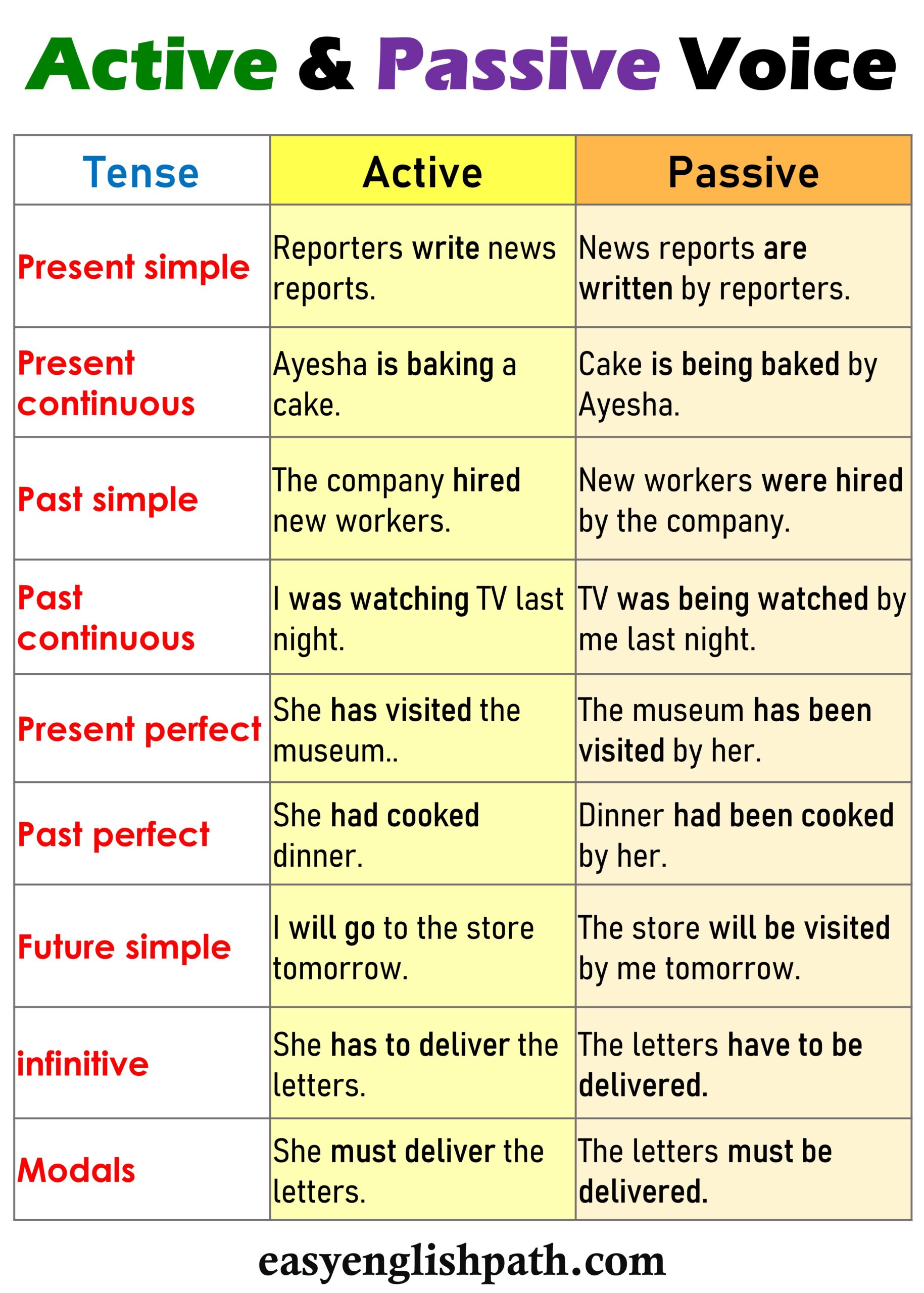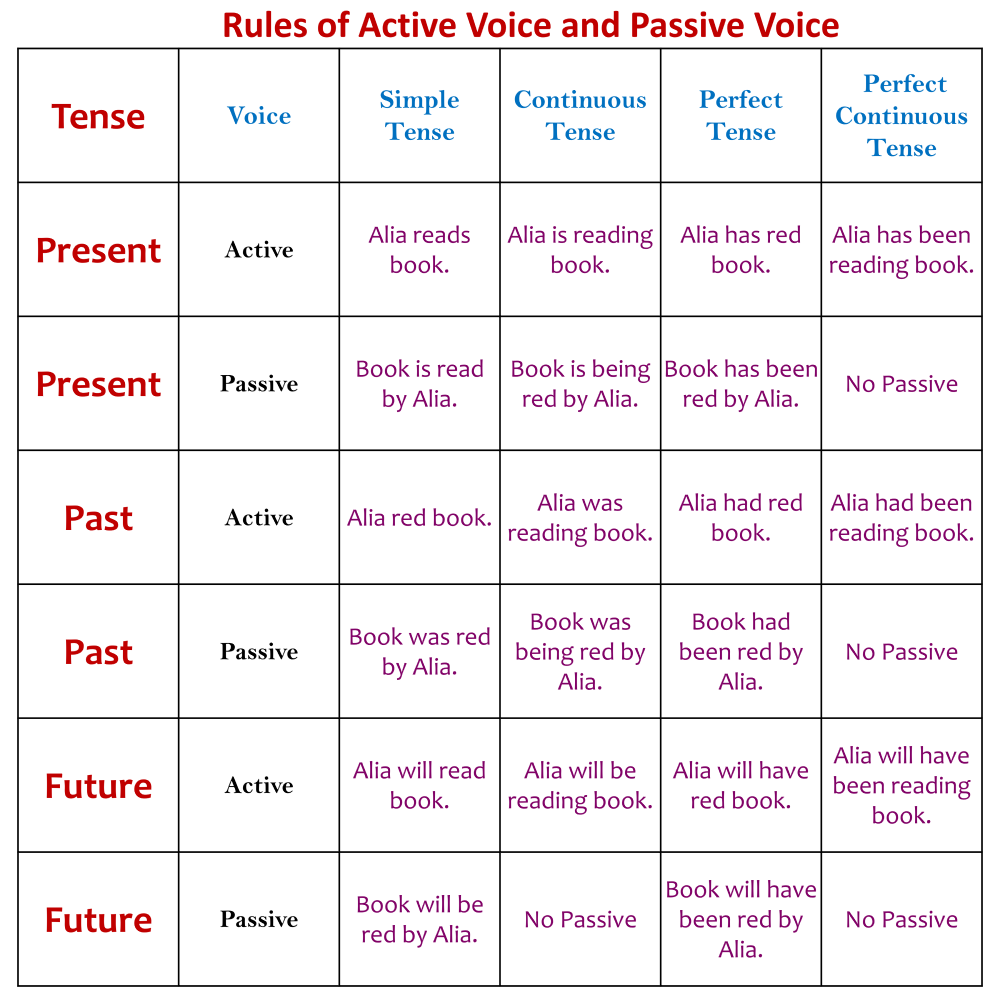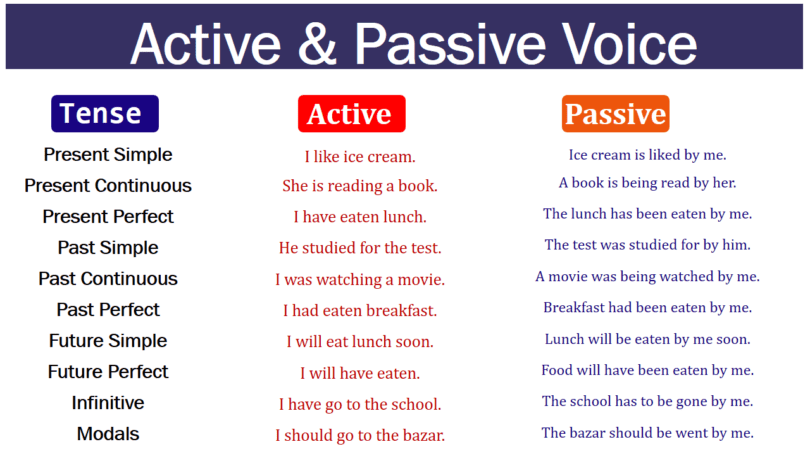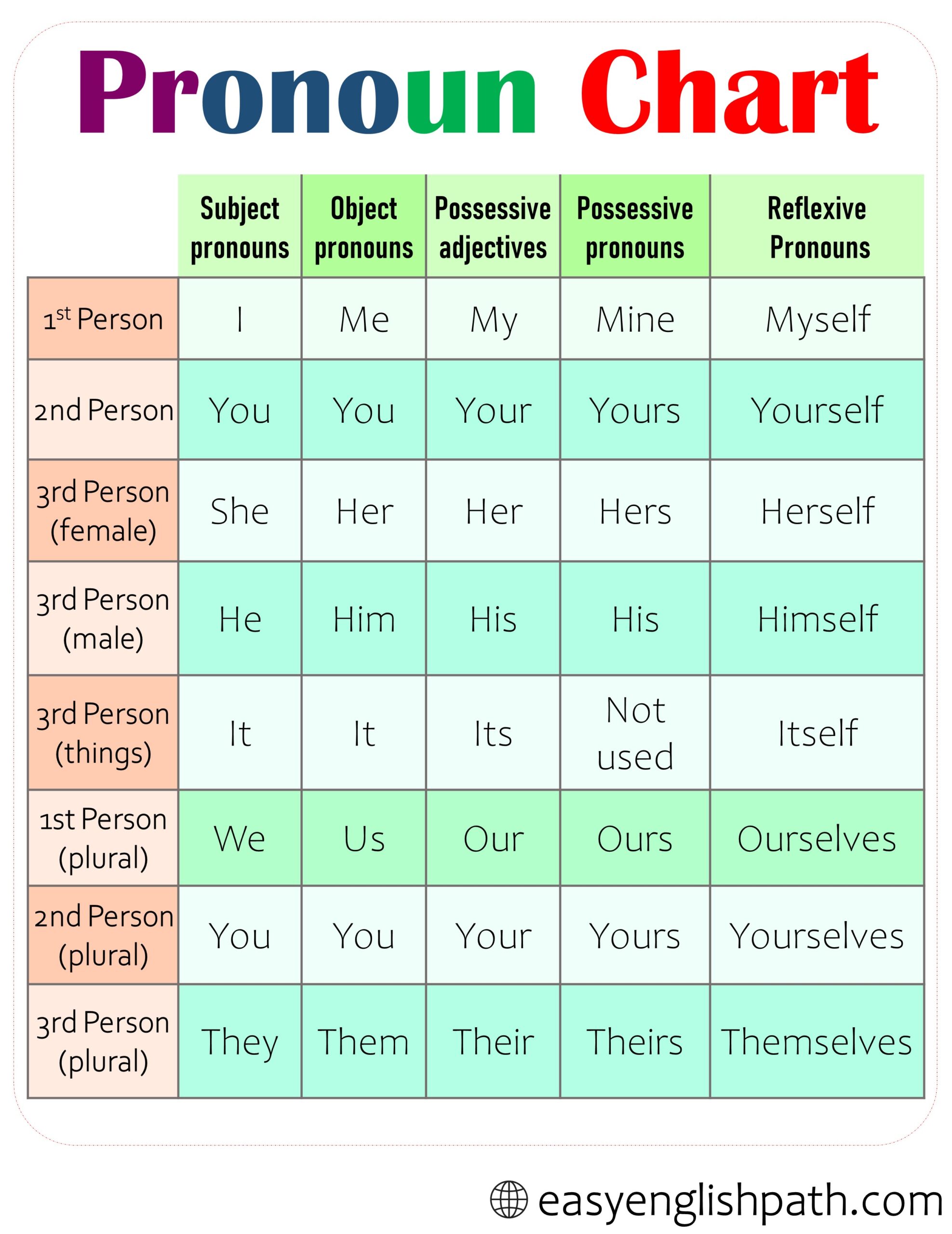Understanding the difference between Active Voice and Passive Voice is important for learning English grammar. In Active Voice, the subject does the action, making the sentence clear and direct. Example: The chef prepares delicious meals. In Passive Voice, the object becomes the subject, which can make the sentence less clear. Example: A picture was painted by me.

What is a Voice?
In English grammar, voice is used to refer to the form of a verb in a sentence that clearly indicates whether the subject of the sentence is doing the action (active voice) or receiving the action (passive voice). It is an important concept to understand sentence structure and the connection between the subject, verb, and object.
Two Voices in the English Language
There are mainly two voices in the English language:
- Active Voice
- Passive Voice
What is an Active Voice?
Active voice is when the subject of a sentence does the action. It makes sentences clear and direct.
For example, The dog chased the cat—here, the dog is doing the action (chased). Using active voice adds energy and helps readers understand who is doing what in a sentence.
What is a Passive Voice?
Passive voice is when the subject receives the action instead of doing it. The object becomes the focus.
For example, The cake was baked by Sarah—here, the cake receives the action (was baked), while Sarah is doing it. Passive voice emphasizes the action or object and uses “to be” + past participle.
Using the Active Voice and the Passive Voice
Active Voice:
- We can use it when the purpose is to make statement clear and direct.
- The doer (who does the action) is the main character.
- it help makes your writing quite engaging.
Passive Voice:
- Use when you want to focus on the action or the receiver.
- When you don’t know or care who did it.
- In formal writing and when you want to avoid talking about the doer.
Active Voice Structure
In active voice:
- The subject of the sentence is the one that preforms the action.
- The verb is used to indicate the action being performed in a sentence.
- The object is the recipient of the action.
For example:
She (subject) eats (verb) an apple (object).
In this sentence, She is the subject, eats is the verb, and apple is the object. This structure clearly shows that who is actually performing the action and what the action is.
Passive Voice Structure
Object of the Action+ Form of ‘to be’ (such as is, was, etc.) +Past Participle (usually ending in -ed or -en)+Agent (optional, introduced by ‘BY ‘)
In passive voice:
- The object of the action is used in the place of the subject in a sentence.
- A form of –> to be <– is used to indicate the tense (e.g.. is, was).
- The past participle form of the main verb is employed.
- The agent (the one that does the action) is optional and may be introduced with ‘BY.’
For Example:
The report (object) was written (form of ‘ TO BE’ + past participle) by Sarah (optional agent).
In this sentence, ‘report’ is the object of the action, ‘was written‘ is the passive verb construction, and
Sarah is the optional agent. The passive voice structure emphasizes the action (writing the report) or the report itself, rather than focusing on who wrote it.
Difference Between the Active Voice and the Passive Voice
Subject and Object:
Active Voice:
In an active voice sentence, the subject of the sentence performs the action.
Example: The cat (subject) chased (verb) the mouse (object).
Passive Voice:
In a passive voice sentence, the subject receives the action, and the performer of the action (agent) may or may not be mentioned.
Example: The mouse (subject) was chased (passive verb) by the cat (agent, optional).
Sentence Structure:
- Active Voice:
The structure of an active voice sentence is as following (subject + verb + object.)
- Passive Voice:
The structure of a passive voice sentence is usually (object + auxiliary verb (a form of to be) + past participle + agent (optional).
Emphasis:
- Active Voice:
Active voice sentences are used to emphasize the doer of the action and are often more direct and clear.
- Passive Voice:
Passive voice sentences are used to move the focus to the action or the recipient of the action, this is what makes them useful for highlighting different parts of a sentence.
Clarity:
- Active Voice:
Active voice is generally considered to be clearer and more concise it makes the perfect and well preferred choice for simple communication.
- Passive Voice:
Passive voice does not sometimes make sentences more clear as much as it is required, especially when the agent is left out in a sentence, Therefore, it is used when the purpose is to emphasize the action is more significant than clarity.
Agent (Optional):
- Active Voice:
The doer of the action is clearly described in active voice sentences.
- Passive Voice:
In passive voice, the agent (the doer of the action) is considered to be optional and may be included or left out. and it actually depends on the writer’s choice or the context.
Tenses:
- Both active and passive voices are used in various tenses (past, present, future). The choice of tense is decided by the auxiliary verbs that are used with them.
In summary, active voice emphasizes the doer of the action and is usually clearer and more direct, while passive voice is used to move focus to the action or recipient of the action and it is used for different purposes, including highlighting different aspects of a sentence or maintaining objectivity.
The choice between active voice and passive voice depends on the context and the writer’s intentions.
How to Change Passive Voice to Active Voice?
in order to change a sentence from passive voice to active voice, it basically includes carrying the focus from the receiver of the action to the doer of the action. Here are some ways that can be used to do this alteration.
1. Identify the Subject and Object:
In passive voice, the object appears before the verb, and the doer is either mentioned after the verb or omitted.
In active voice, the subject (doer) comes before the verb, performing the action.
2. Rewrite the Sentence:
The subject (doer) must move to the beginning of the sentence.
The object (receiver) follows the verb.
The verb must be adjusted to fit the new sentence structure.
3. .Adjust Verb Tenses and Conjugation:
Ensure the verb tense and conjugation match the new sentence structure.
The verb must agree with the subject in number and tense.
4. Remove the Agent (Optional):
In passive voice, the agent (doer) is often introduced with “by.”
In active voice, you can include or omit the agent depending on context.
Example:
- Passive: The book was read by Sarah.
- Active: Sarah read the book.
In the passive sentence, The book is the object receiving the action, and Sarah is the doer.
In the active sentence, Sarah becomes the subject and doer, while the book remains the object.

Common Mistakes in Active and Passive Voice
1. Incorrect Verb Agreement
❌ The cake were baked by Mary.
✅ The cake was baked by Mary.
2. Omitting the Doer (When Necessary)
❌ A decision was made.
✅ The manager made a decision.
3. Using Passive Voice Unnecessarily
❌ The report was written by me.
✅ I wrote the report.
4. Incorrect Placement of Object
❌ Was the letter sent to John by you?
✅ Did you send the letter to John?
5. Mixing Active and Passive in One Sentence
❌ The teacher gave instructions, and the assignments were completed by students.
✅ The teacher gave instructions, and the students completed the assignments.
Active and Passive Examples
Active Voice:
- She sings a song.
- They play soccer.
- He wrote a story.
- The chef cooks a meal.
- I painted a picture.
- The dog chases the cat.
- We visit the museum.
- They clean the house.
- The teacher explains the lesson.
- The company makes cars.
- The kids ate cookies.
- I fixed a window.
- The gardener waters plants.
Passive Voice
- A song is sung by her.
- Soccer is played by them.
- A story was written by him.
- A meal is cooked by the chef.
- A picture was painted by me.
- The cat is chased by the dog.
- The museum will be visited by us.
- The house is cleaned every Saturday.
- The lesson is explained by the teacher.
- Cars are made by the company.
- Cookies were eaten by the kids.
- A window was fixed by me.
- Plants are watered by the gardener.
FAQS with Active and Passive Voice
1. What is the difference between active and passive voice?
- In active voice, the subject performs the action (John wrote the book).
- In passive voice, the object receives the action (The book was written by John).
2. When should I use passive voice?
Use passive voice when the doer is unknown, unimportant, or to emphasize the action (A mistake was made).
3. How do I change passive voice to active voice?
Move the doer (subject) to the beginning, adjust the verb, and place the object after it (The cake was baked by Mary → Mary baked the cake).
4. Does passive voice always use “by”?
No, the doer can be omitted if it’s unnecessary (The rules were changed yesterday).
5. Is passive voice incorrect in writing?
No, but active voice is clearer and more direct. Use passive voice when needed for emphasis or object focus.
You May Also Like






